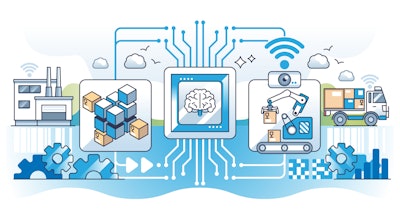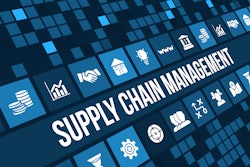
The adoption of artificial intelligence (AI) in supply chain and logistics is revolutionizing the industry, producing efficiency, increasing speed and contributing to resiliency in operations. AI is quickly emerging as a common tool to overcome traditional challenges and enhance decision-making. Central to this transformation is the strategic use of data, which fuels AI models and allows logistics companies to anticipate disruptions. AI is here to stay, and it's shaping the entire industry as we know it.
Michael Hung, CEO at TradeBeyond, explains that today, AI is driving massive improvements across supply chains by adding accuracy and speed to traditionally manual processes.
AI as a solution to challenges
Supply chains are inherently complex, and this complexity creates challenges in visibility, accuracy and response time, which are exacerbated by external disruptions including geopolitical shifts and natural disasters. There are 3 main spaces where AI is thriving: demand forecasting, inventory management and transportation planning.
Steve Dombroski, director, consumer markets at QAD, says with AI, demand forecasting becomes much more accurate by analyzing various data sources—like social media trends, weather patterns and economic indicators—that influence consumer demand. This helps businesses anticipate what people will need in the future, making it easier to avoid overproducing or running out of stock.
"In demand forecasting, AI analyzes huge data sets—like sales history, market trends and even weather patterns—to better predict customer demand. For the food and beverage sector, this includes seasonal adjustments to account for peak demand during holidays or trends affected by extreme weather events that impact fresh food availability. This allows companies to avoid the risks of overstocking or running out of stock, aligning production more closely with actual demand," says Hung.
Traceability is a hot topic in the discussion about inventory management, especially where food and beverage is concerned. Hung says AI-enhanced chain of custody solutions streamline the process by automating documentation review, rapidly identifying inaccuracies or gaps, and consolidating data across all ingredient levels; this capability simplifies compliance with the increasingly rigorous food safety and traceability regulations enforced by countries worldwide, ensuring the accuracy and completeness of the entire ingredient trail, from raw materials to finished goods.
For Dombroski, managing inventory means balancing how much stock is on hand without overcrowding warehouses or running short.
"AI can monitor sales, supplier timelines, and even seasonal trends to keep inventory levels optimized, reducing excess stock and preventing shortages. For instance, if AI identifies a sudden spike in demand for a specific item, it can automatically adjust inventory orders to meet that demand without wasting space or resources," says Dombroski.
 Software for transportation planning and tracking.Abas/stock.adobe.com
Software for transportation planning and tracking.Abas/stock.adobe.com
And a modern transportation management system (TMS), for example, could have integrations that produce more accuracy through the use of AI software.
"Transportation planning benefits from AI’s ability to improve routing, predict delivery times, and manage logistics costs," says Dombroski. "AI analyzes factors like traffic patterns, fuel costs, weather conditions, and even driver schedules to select the most efficient delivery routes. This reduces delays, saves fuel and can even lower shipping costs by choosing optimal routes."
The adoption issues
One of the challenges in AI adoption is integrating it with legacy systems. Companies are overcoming this hurdle through real-life application and considerations behind what software works best, where Thor Olof Philogène, co-founder and CEO at Stravito, says before investing time and money into AI powered solutions, AI leaders must first identify real-life pain points of existing systems and legacy software and understand how AI solutions can benefit them.
"Another aspect to consider is change management. Time should be taken to explain both the limitations and strengths of the technology being integrated to stakeholders, empowering people with knowledge," says Philogène. "This mitigates anxieties around the results of the change and gives them agency to ask questions and take an active role in participating."
Oftentimes, companies are tackling the integration issue by using multi-enterprise platforms that bridge the gap between older systems and new AI tools. These platforms allow for seamless data exchange without the need to completely overhaul older infrastructure, says Hung.
"Best practices for smooth AI implementation include starting with a data readiness assessment to ensure that existing data is clean and well-organized," explains Hung. " Many companies also roll out AI in stages—focusing on specific functions like inventory management before expanding across the entire supply chain. This phased approach helps reduce disruption and allows teams to learn and adjust as they go."
Why data is the fuel
Data is the lifeblood of AI applications. As more logistics operations adopt digital technologies, they generate vast amounts of data at every step of the process—from suppliers and manufacturers to warehouses and customers.
"Ensuring high-quality data is foundational to making AI work effectively. Many companies are adopting data governance frameworks to standardize how data is collected, validated, and managed across the organization," says Hung. "These frameworks ensure consistency and accuracy in data, preventing issues like duplication or outdated information. However, the main challenge often lies not just in legacy systems but in the fragmented nature of data, with crucial information stored across disparate systems that may not interact with each other."
In an example from Philogène, given the widely reported issue of "hallucinations" in some generative AI tools, organizations that rely heavily on accurate market and consumer research should ensure they implement tools that generate insights exclusively from vetted data, not from open-source or publicly available data. Furthermore, Philogène stresses, when integrating the data, the technology should be complemented by a human-run service layer to ensure its effectiveness.
Companies are tackling data quality issues by setting up ways to collect data in a consistent format and adding tools that can automatically catch and fix errors as they appear, explains Dombroski. "They also check data regularly to make sure it’s current and accurate. These steps mean AI systems can work with reliable, up-to-date information, which is key for making good predictions and decisions in the supply chain."
 AI chatbot technology.Sutthiphong/stock.adobe.com
AI chatbot technology.Sutthiphong/stock.adobe.com
"Demand forecasting is also set to benefit from AI’s enhanced predictive capabilities. With its ability to analyze and correlate real-time demand signals, AI will play a critical role in the food industry. Accurate, AI-driven forecasting will minimize the likelihood of costly product waste, aligning production with consumer demand and ensuring fresher products on shelves. And in inventory management, AI will drive improvements in key performance metrics like 'inventory turns' and 'days on hand.' By optimizing inventory based on real-time and predictive data, AI helps reduce excess stock, improve turnover, and ensure fresher products are available to consumers. Its ability to perform complex, multivariate analysis will allow for more precise inventory management, supporting efficient stock replenishment and reducing product spoilage," says Hung.
With data at its core, AI is helping companies make better predictions, optimize routes, manage risks and improve visibility. As these technologies continue to advance, companies that harness the full potential of AI will gain the most competitive edge in the race towards technology optimization.






![Top Tech Logo Vertical [color]](https://img.foodlogistics.com/files/base/acbm/scn/image/2024/11/top_tech_logo_Vertical__color_.672d2a7c2733d.png?auto=format%2Ccompress&bg=fff&fill-color=fff&fit=fill&h=167&q=70&w=250)













